- You talk about writing not being to0 long even past a 1,000 words if the writing is well done, but is there a point where you feel enough is enough?
- What is your favorite type of article to read?
- What are your feelings on AI? Do you think it will help us in the long run or take over like Hollywood loves to show?
- How did you end up where you are today? Do you enjoy being a writer in the marketing field?
Author: collivett2
VR Reflection
While VR promises a lot and could eventually give a user them ability to transcend time and space and be anywhere at any time. The one VR I watched was the one that followed the new horizon spaceship to Pluto. It makes you feel so small to watch yourself so far away from your home and the Sun. It was amazing to see Pluto so up close and personal.
VR will allow publishing to take the reader anywhere and see whatever the author wants them to see. Just like TV’s did VR opens up a world of possibility that allows the viewer to be submersed in the content. Publishing will expand and allow the viewer to be more involved in the story.
I think VR does make the viewer feel connected and so they experience more emotions then just watching a screen. I do believe in the right set up and connection a viewer could feel empathy.
On a personal note, VR causes me to feel sick every time i use the technology. I am sure i am not alone in this issue and it will have to be overcome to get any real use or enjoyment out of the tech. I also experienced crappy wifi and the issue of having a very pixelated phone. So while the technology is not perfect today and it has a lot to overcome i can see it growing in the future.
Asylum Seekers World Map ~Maureen & Chris

Asylum seekers have to leave their homes for fear of their life and safety. That issue has spread across a wide swath of the world and has impacted and displaced millions. This interactive map can be used to show you a range of facts about a global issue. While not every country could be included the map shows the most common countries that Asylee Women Enterprises asylum seekers come from.
Syria:
With the start of the Syrian Civil War in 2011, violence has raged throughout the country. Since its start, almost 400,000 people have been killed, including 14,000 children. Eleven million have been displaced, five million fleeing the country itself. While most Syrians stay in the Middle East, many flee to the United States to regain freedoms they have lost.
For more information:
https://www.worldvision.org/refugees-news-stories/syria-refugee-crisis-war-facts
Back to top
Afghanistan:
With the presence of a war and foreign armed forces, Afghanistan has been deteriorating. Fighting and drone strikes from these foreign nations occur far too often, killing countless civilians just for the possibility of destroying the Taliban and ISIS. More than 3,500 civilians were killed and more than 7,400 wounded in 2015. More than 2.5 million Afghans are living abroad as refugees. It is a fear of many that refugees coming to the United States are apart of ISIS, but that is who they are fleeing. The people are being oppressed and are seeking refuge in the land of the free.
For more information:
https://www.democracynow.org/2016/4/13/americas_afghan_refugee_crisis_15_years
Back to top
Congo:
From 1997 to 2003, the Democratic Republic of the Congo experienced a violent civil war. Since then, the extreme level of violence and human rights abuse have caused thousands to flee the area to surrounding countries, many with the goal of resettlement in America. Many refugees suffer from a high degree of trauma from exposure to violence, torture and assault, and require professional medical attention.
For more information:
https://borgenproject.org/facts-democratic-republic-of-the-congo-refugees/
Back to top
Nigeria:
Since the conflict in Nigeria has started, 2.6 million people have been displaced. The conflict has brought the country a lack of resources, which has led to more malnutrition and poor health. More than 14 million Nigerians are in need of compassionate aid. With the unrest, about 200,000 refugees have fled to friendlier countries. While people have started to return to their homes, the overall social mood has changed. The conflict has deteriorated the economy, caused more social tensions, disregard for different people, and unease between different social classes and groups.
For more information:
Back to top
Ethiopia:
Ethiopians are fleeing their homelands because of the massive human rights violations associated with forced relocation and the confiscation of their property. Their homes have been destroyed, their property taken by the state, religious persecutions and forced labor, and inhumane practices by the militia, such as rape and kidnapping. Their freedoms have been taken away so they are seeking refuge in a free land such as the U.S. among other surrounding African countries.
For more information:
Back to top
Mexico:
Unrest in Mexico has taken a turn for the worst due to an aggressive war against drug cartels. This has caused the number of Mexicans trying to escape the war to flee to neighboring countries like the U.S. and Canada. In the U.S. Mexicans are the second largest group of asylum seekers but only have about a 9% chance of getting approved as an Asylum Seeker in the U.S. While getting to Canada now requires a visa to book an international flight to the country. Seekers can attempt to cross the border, but would then have to take shelter in the U.S. system over Canada’s immigration system. With the growing violence of the drug wars the problem does not seem to be resolving or growing better.
For more information:
https://nacla.org/article/mexican-asylum-seekers-canada-door-closes
http://jmhs.cmsny.org/index.php/jmhs/article/view/40
Back to top
El Salvador:
El Salvador continues to be plagued by high levels of crime and violence that have made many communities extremely dangerous, especially for children and young adults. In 2016 alone, there were 5,728 murders registered, one of the highest since the end of the country’s civil war in 1992. This violence stems from many origins including drug smuggling and gang activity, especially in poorer areas. Getting away from this violence is important to many families and seeking asylum in the U.S. is the way to do this.
For more information:
https://www.wola.org/analysis/people-leaving-central-americas-northern-triangle/
Back to top
Pakistan:
With the growing unrest in Pakistan more than 1.2 million Pakistanis have been disturbed and forced from their home by instability and violence. While aid would normally be provided, Pakistan is not involved in an official war so many asylum seekers are disregarded at a global level. Asylum seekers flee Pakistan by crossing the border on foot and bus and then flee farther to Europe for protection. Even once the seekers have arrived, they face the danger of being detained or sent back to Pakistan. Pakistan’s nonexistent legislation concerning refugees means there is no local or nationwide protection for them. The only governing documents on asylum seekers is the 1993 Cooperation Agreement, between the government of Pakistan and the United Nations Refugee Agency, which determines their eligibility.
For more information:
https://borgenproject.org/10-facts-pakistani-refugees/
Back to top
Russia:
Russian asylum seekers escape from Russia due to its civil tyranny, discrimination minorities, and unfair treatment of the LGBT community. While Russia does hold “free” elections by most accounts they are rigged and unfair. People who speak out against the ruling party, may end up being prosecuted or arrested. If convicted they can be sent to a Russian jail which has some of the worst living conditions on the globe. Free speech is limited by the government and is closely monitored and censored. These limitations, human rights violations and unfair elections has led many citizens to flee the country in hopes of a better and safer life. Many try to flee to other countries and more than 5,500 seekers crossed the border into Norway in hopes of escaping. Due to political tension more than a dozen people last year were sent back to Russia and faced unknown consensuses.
For more information:
https://www.hrw.org/news/2016/02/03/norway/russia-dont-jeopardize-asylum-seekers
Back to top
Baltimore:
The American dream is a sought-after goal that very few have the advantage of achieving. For Asylum seekers that new iPhone or fancy car is not the American dream but the ability to be who they are (LGBT or a woman) without the fear of harassment, rape, judgment, or harm. The dream could also just be wanting a safe life away from war, violence, and political oppression. Thousands of immigrate to the U.S. each year but the process once they are here can be a long and difficult one. Baltimore is a great intake city due to its diversity, position on the eastern seaboard, and many different opportunities. Baltimore’s central location, proximity to government resources, and transportation via multiple airports allow asylum seekers an easier time coming here. Asylee Women Enterprises (AWE) hopes to help rebuild these Asylum seekers lives one family at a time. Being one of only a handful of places that focus on Asylum seekers on the east coast AWE and Baltimore are a highly sought after destination for those fleeing. While this may be a global issue that needs a global response, there are opportunities in your own backyard to make a difference.
For more information:
https://www.rescue.org/united-states/baltimore-md
https://therefugeecenter.org/voices/refugees-are-contributing-members-of-the-american-society/
Back to top
Updated April 2017
Chris Friend Questions
- Do you ever feel more pressured to write now that you have a place to write? If so do you feel it has changed your writing.
- Do you have a favorite article? If so why is it you favorite?
- In your opinion does publishing on the web change the way a person writes as compared to if you wanted to write these articles for a magazine or other print publication?
Annotated Biography – Chris Ollivett
Annotated Biography
“Norway/Russia: Don’t Jeopardize Asylum Seekers.” Human Rights Watch, 5 Feb. 2016, www.hrw.org/news/2016/02/03/norway/russia- dont-jeopardize-asylum-seekers. Accessed 3 Apr. 2017.
Unfortunately, there was no author listed as the writer but the source of the article is the Human Rights Watch, which closely follows all progressions and conflicts that people face around the globe. The main claim seems to be that Russians asylum seekers need to be given a fair review of their cases before they are sent back from Norway to Russia. The thesis states that these cases are often overlooked and these people are being returned to a country that they once fled. The intended audience seems to be the Norway government and people who could change the current system to be more friendly and fair to Russian asylum seekers. Its secondary audience would be anyone looking to keep up on global human rights issues.
The article is written by the Human Rights Watch group and it does have an obvious bias towards its argument that asylum seekers deserve a fairer process. The article is meant to inform and perused people so it is slanted in its delivery of information. The articles strengths would be its ability to put an emotional spin on pure facts, while making it clear that a change is needed to protect these asylum seekers. It is very detailed and gives compelling facts that may not have been well known before reading this article. The only weakness the article has would be its heavy bias with no real rebuttal to any possible augments made against the facts. The facts and information would greatly help me show that while most people think asylum seekers come from 3rd world country’s they are wrong. Russia is a prime example of a first world country committing offenses against human rights and forcing people to become asylum seekers. This material is very relevant and right on point in helping me create facts centering around Russia and its asylum seekers. Tiffany marked it as a troubling place and it is important that people see the global scale of these issues which this article nails home.
“Rescue Lives in Baltimore, MD.” IRC, International Rescue Committee, www.rescue.org/united-states/baltimore-md. Accessed 3 Apr. 2017.
The Author of this article is unidentified but the sponsor of the article is the International Rescue Committee. They are located across America and help Asylum seekers and refuges who are fleeing their home country to come to a safer home. The articles main purpose is to inform the reader about the struggles and the massive number of people fleeing their homeland each year. Its thesis is that these people deserve a free life away from harm and deserve a chance to be happy in America. The intended audience would be anyone looking to understand the local reality of asylum and immigration seekers. This article focuses on Baltimore and gives fact that most people would not know or care to overlook. It secondary audience after informing people would be to illicit a response to get people to act and help out the cause.
While the article could be bias it does not show up all the time. They do list facts and tell stories that presents their cause in a good light, but the article is not always noticeably bias. It could be considered slanted in the way that they list how their organization tries to help all these incoming people. The strength of this article is its ability to make the reader feel connected and have them get involved. It is a great idea for AWE to have something like this under their own Baltimore part of the map. It makes a reader go from looking for information to wanting to be involved. The weakness of this article is that it has many cool facts but not a lot of substantial facts that can be used. The information would defiantly help out the argument and has given me a really good idea for what to include in the Baltimore point of the map and how to structure it. Lastly the information is relevant in the way that it really hits home. Like one fact is that the maker of the famous old bay spice was not even from this country, but immigrated here.
“RESTORING WHAT’S BEEN LOST.” USCRI, U.S. Committee for Refugees and Immigrants, refugees.org/explore-the-issues/refugees-facts/. Accessed 3 Apr. 2017.
While the site is run by the U.S. Committee for Refugees and Immigrants it does not list an author for this page. The site is dedicated to helping people from around the world whether refugees, asylum seekers, or immigrants resettle in the U.S. The thesis seems to be that there is a scarcity of resources available to seekers which can cause them to lose hope of ever finding a normal home and life. The main claims are that more needs to be done to help these people. The developed world is not taking in enough seekers to help offset the massive number of people displaced, and that this is a global issue that effects millions around the world. The intended audience for this site would be people looking to learn more about issues that plague seekers and refugees while also hoping to obtain donations from people.
The article is very good at presenting facts in a colorful and well laid out manor, which seems to keep any bias down to a minimum. The page is set up in a way where the facts are broken down and while it does not have a very personal connection the facts do a good job at convincing a reader to act while have no slant or bias. The strength of this page is the ability for it to lay out so many dry facts, but keep the reader’s attention through every last one. The page breaks down each fact in a picture or drawing and makes you feel closer to the fact. It also helps break up the page. The weakness of it would be the lack of a personal story to tie into all the facts given. There really is not true weakness and the map found on here is a great template for the project I am looking to do. It supports my idea in every way imaginable from facts to providing me with a map to see how I should start my own. The information will help me write about some points on the map as well as providing information in general about seekers and refugees.
Sturm, Nora. “UNHCR Calls for Urgent Action as Central America Asylum Claims Soar.” UNHCR, United Nations High Commissioner for Refugees, 5 Apr. 2016, www.unhcr.org/en- us/news/latest/2016/4/5703ab396/unhcr-calls-urgent-action- central-america-asylum-claims-soar.html. Accessed 3 Apr. 2017.
Nora Sturm is the author of the article and her background consists of being a Research and Communications Officer for the UN Secretary-General as well as working for the UNHCR, Human Rights Watch. The thesis is that more needs to be done to protect and help the people of central America due to its growing asylum and refuge seekers. In some countries, the number of seekers has increased tenfold. The main claim made is that Mexico and other countries cannot handle the sudden wave of seekers fleeing and entering its borders. This creates issues in providing for them and protecting them. The authors intended audience would be information seekers on global issues. A person would not visit this sight unless they wanted news on issues around the globe.
The article seems relatively unbiased in its form of presenting facts and saying more needs to be done. It could be slanted to better state her argument but it is not a very noticeable or prevalent slant. The article is very emotional and passionate in its writing but it feels weak on the research and facts part. I can tell she wants to pull on heart strings but the facts seem to get lost in the writing. While the strength is in the passion on the article its weakness seems to be the lack of facts supporting the overall information. The information in this article does support my paper and helps to show that a global issue requires a globe response. The material has some good points but it is not the most relevant to my paper. I can use pieces of it but it helps me see how to add emotion into the facts but also warns me not to get carried away.
Book Traces
The Book Traces event was very enlightening! At this event, I got to take away an idea about books that I had never thought about before. For me I love the ability to hold a physical book in my hands. Reading from a computer is fine in short spurts, but a novel deserves to be read from paper. While I am sure a lot of people do not feel the same way this event just renewed my faith in how important physical books are. Each book that we saw was like a time capsule holding flowers, hair, toys, or stories of people’s lives. These people did not have a claim to fame, but their stories are powerful and enlightening. I personally have a family bible that I put flowers in after each family member has passed. It’s a way to remember them even after they have gone. It never occurred to me that books can be stories and pieces of history in themselves. These books can hold a look into a person’s life that would have been lost if discarded. I hope this project is expanded so more books can be collected so not to lose a hidden part of history. While I understand, the digital age is here and never going away my hope is that more people get to see this event. People need to see that some books can hold more stories then just the printed one.
AWE Pitch
The growing need to support asylum seekers cannot be ignored! The list of countries that have multitudes of asylum seekers fleeing has grown over the years. That list now includes: Iran, Iraq, Pakistan, Afghanistan, Sudan, Eritrea, Bangladesh, Albania, India, Nigeria. (Who’s Who) In 2014, 1.8 million people were waiting to hear about their asylum claim. (Asylum-Seekers) That figure has only grown with mounting unrest and instability in many regions of the globe. The AWE website needs help providing funds to the program in addition to information for potential donors. This is key to helping these millions of people currently in the process or looking to start the process of seeking asylum. A website that can present the mass amounts of information about asylum seekers like: “Almost all asylum seekers are not allowed to work and are forced to rely on state support – this can be as little as £5 a day to live on.” (Who’s Who) or the fact that they “…can be sent back to their country of origin.” (Home) which would most likely ensure a hard life or death. To present this info on the main page, a two-layer world map would be used to show where asylum seekers flee from and where they end up calling home. On the map, will be pins with facts and if possible some pictures showing the heartache and pains found in their home countries. The seconded layer will show where they end up. This part will hopefully include interviews from AWE staff helping to tell these woman’s stories to provide an emotional connection as well as facts that make the reader engage. They will be asked questions about the most touching moments they felt at AWE, what brought them to AWE, what is the biggest struggle these women face, and many others. The map will be an interactive way for the primary audience which, are donors to learn and feel connected to the asylum seeker. This is a global issue that needs a global response starting with AWE. Improving AWE is the first step to improving asylum seekers resources and lives.
Work Cited
United Nations High Commissioner for Refugees. “Asylum-Seekers.” UNHCR. Web. 16 Mar. 2017.
Refugee Council. “Who’s Who.” Refugee Council U.K., Web. 16 Mar. 2017.
Lawrence, Callan. “Home.” What Is the Difference between a Refugee and an Asylum Seeker? – Settlement Services International. Web. 16 Mar. 2017.
Letter Press Workshop~Chris
When I first heard the words Letterpress, I think of Ben Franklin sitting around printing newspapers in the original 13 Colonies. Little did I know that the letterpress was invented a few centuries earlier in the 14th century. The printing press workshop made me realize how much work had to go into each word, line, and overall work. Each letter had to be properly placed and aligned. If the words did not get checked they may move or be worn down and not ink the paper properly. There are just so many variables that could go wrong. The modern printer makes us take the work of printing for granted. Modern Word allows us to check and change our thoughts and words with an easy strike of the keyboard.
At the workshop, we got to create one thought in each group and print that to a poster. While one thought may sound easy to come up with it took us over fifteen minutes to place and set the words. Having to place each letter while figuring out what to do when the word does not fit or the spacers leave a miniscule gap. The process is tedious and time consuming. Even getting the print onto paper can be challenging. The letter that took so much time setting and placing can be worn down and not print since lead is a soft metal. The ink can be an undesirable color, because to much ink was applied. So much time and effort has to be performed just right or the print will come out wrong.
What I took away from this workshop is how much we take all the behind scene effort of printing for granted. The computer and printer make everything so effortless but that was not always the story. With that said, the amount of work that goes into printing on a printing press allows a person to really take pride in what they have created. The finished product can look so much cooler than anything a printer throws out. When I move back for summer I am finding a place on my wall for the poster that I helped to create.
Five Questions for Asylee
- What do you feel are the most important parts to incorporate into the new website?
- What about the three example websites do you feel are the most important that you would like to see done with your new website?
- What about the old website would you like to see redone and used in the new site?
- What do you feel like is the most important aspect of Asylee Woman Enterprise?
- Do you have a favorite part about your job/ organization?
Rhetorical Analysis: Heifer ~ Chris Ollivett
Rhetorical Analysis
The website I chose to analyze was the Heifer project. The reason I chose to look at their website over the other two was because of their unusual way of giving. The Heifer project allows a person to donate money by buying an animal or supplies that can be directly donated. So, the audience of the website can feel directly connected to their gift and the effect it will have. The primary audience is any available donor who would be willing to give the project any amount of money. The site makes it effortless to donate with call to action buttons located at the bottom and top of most pages. The buttons to donate are well labels and normally a bright color. The secondary audience would be anyone looking for basic information on the organizations goals, priority’s, and work. While the donation buttons are all over the website, so is information telling about all the positives the Heifer project has done over the years. The website appeals to both audiences by easily displaying information that shows the Heifer project in a good light.
The purpose of the Heifer projects webpage is to gather donations and allow people to feel connected to the cause while donating. This is easily done by the donor’s ability to pick a specific animal that they want to give. An example would be the ability to give a donkey or goat to a person in need. In addition to this purpose, it is easily possible that the websites information is given to make it look like a worthwhile place to donate. While all the information is positive it makes, the visitor feel like they should donate. All the facts would make any person feel like they can help.
The context is displayed in the form of a website because the world has become digital. This means that the easiest way for the Heifer project to spread their message and to receive money is to be online. It allows the organization to reach a broad range of people cheaply. The website is very well connected to the social age having links for all current forms of media (Facebook, Instagram, Twitter, etc.) The organization also has a blog which allows people to be kept up to date on all things Heifer project related. The website would easily be read on a computer, tablet or phone. It would most likely be read by a person looking to donate so they would probably be in their own home.
The author would be the Heifer project which means there will be a constant bias to making themselves look good. I do trust them for the most part, but would investigate a little before donating money. The sites creditability is important because if no one trusts it then they will not get funding. They come off as being sincere and wanting the reader to understand what their purpose and goals are. The Heifer project has a reputation for helping people and seems to prove this as fact on their website. The site works very hard to make the project sound very trustworthy and reputable.
The genre would be informative due to its contents nature. All the information found on the site are facts or story that prove the organizations ability to help and farther people. It turns impoverished people into stainable ones by giving them tools.
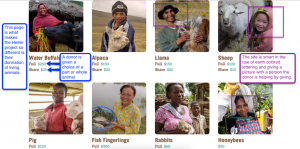
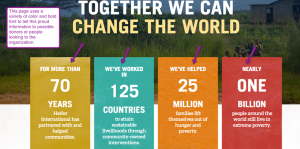
Color: As the site is shown above its use of color is vibrantly expressed all throughout the web page. The color is used to draw the reader into the story of Heifer and connect them with the people that their donation will benefit. On the lower picture, it also shows how they use color to present important information that highlights their accomplishments.
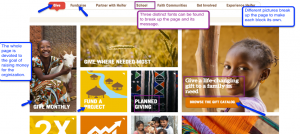
Font: The font changes to express what is meant to be highlighted on the page. Different blocks above use different fonts to make the page have differentiating blocks that don’t feel old after a few looks. The font is also used to highlight the donation links as that is the primary motive behind this website.
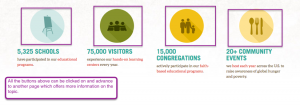
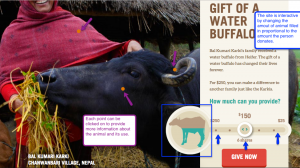
Information Architecture: The website flows together Allowing one piece of information to connect or pop up more information for the reader. The information is well laid out in its transition and interaction with the reader. In the first picture, big colorful buttons provide a pop out menu which can be clicked on to search even more information on the subject. The second picture right above provides an interactive experience that provides the donor with an interactive way of becoming informed and donating.
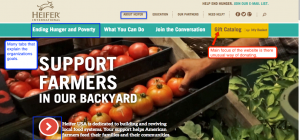
User Experience: The primary task of the site is to provide people with a way of donating so the Heifer project can continue its work. With that in mind they guild the user to multiple call to action buttons that allow them to donate from many different points. They incorporate two main task bars that can navigate through the website. They also incorporate social media links and at the very being ask if you’re a donor or not when you first log on
The Heifer organization does a great job in using their website to draw out possible donors and inform readers. The sites main application would be to possible donors, with a second audience being people looking for information on the organization and what it is about. Just like any other website that was designed for one of these fundraising and humanitarian organizations its purpose is to inform and collect donations to further their efforts. While the site has a natural bias in making their numbers look good. The overall feeling is one of trust due to the websites overall feeling and presentation of facts. I could not really see where the bias got in the way of the facts.
The authors ability to use a website to collect money and share information is far superior to say mailing out pamphlets and an envelope hoping for people to return with money. A website allows for a vast array of information to be presented and for interaction such as buying a share or a whole animal to donate. The author was ability to make the website informative but never made it seem redundant. The site uses Facebook, Twitter, blogs, and email to allow a person to communicate and share in any way they chose.
In closing I learned a great deal from my time on this project. From how to use JING to how website use different colors and fonts to draw a view to the information they want them to see. I used JING because it was recommended and I found it to be easy to use. The only caution I found with it was that once you saved the annotated picture that was the last time you could edit it. JING was easy to use and allowed me to make some nice points right onto the picture. I started by first looking at the website and then picking out what screenshots I wanted to use in the analysis. The website as a whole is one of my favorites due to its interactive use, colorful display, and unique way of fundraising. After I collected all my screenshots I wrote the paper portion around them to try and give it a seamless flow. I found this project really enlightened my understanding of webpages and has me look at them with a more detailed eye then before.
Work Cited
“Heifer International | Charity Ending Hunger And Poverty.” Heifer International | Charity Ending Hunger And Poverty. N.p., n.d. Web. 21 Feb. 2017.
